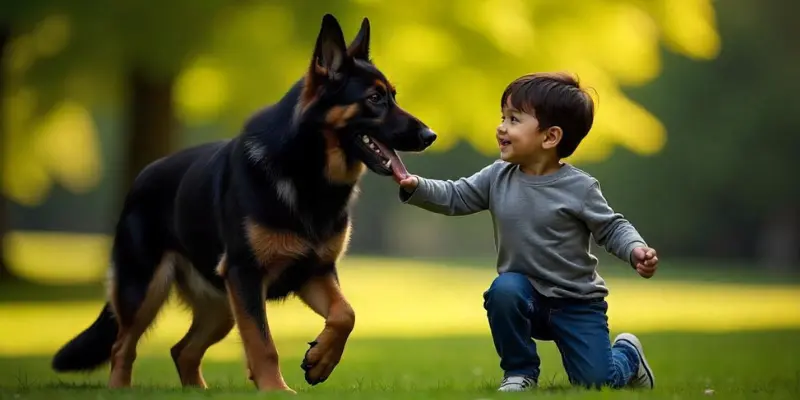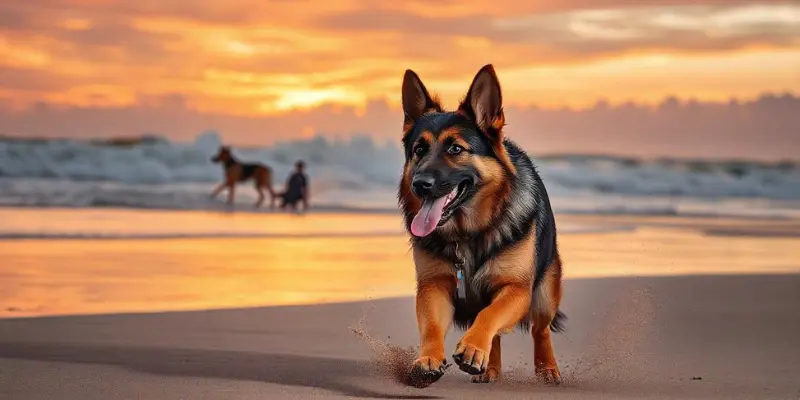Black And Brown German Shepherd: Facts, Photos & More
Updated: November 12, 2024
14
The black and brown German Shepherd is a popular and distinctive variation of the German Shepherd breed. Known for their intelligence, loyalty, and versatility, they are cherished as family pets, working dogs, and service animals. This guide will explore their unique physical traits, reasons for coat color changes, and interesting facts about black and brown German Shepherds to comprehensively understand this beloved dog breed.
The Unique Beauty of Black and Brown German Shepherds
The black and brown German Shepherd is characterized by a striking black and brown coat, with each color often arranged in a classic saddle pattern. Their physical beauty, well-known intelligence, and protective instincts make them one of the most sought-after dog breeds. Below, we’ll explore their physical characteristics and what makes them stand out.
Physical Features of Black and Brown German Shepherds
Typical Characteristics
Black and brown German Shepherds possess muscular bodies, pointed ears, and intelligent, almond-shaped eyes that convey alertness and loyalty. Their double-layered coat has a soft undercoat and a denser outer layer, making them well-suited for various climates. The black coloration typically forms a “saddle” shape on their back, while the brown is seen on the legs, underbelly, face, and sometimes around the ears and chest.

Unique Traits That Distinguish Black and Brown German Shepherds
What sets the black and brown German Shepherd apart from other colors within the breed is the classic saddle pattern that creates a defined and regal look. This coat pattern is the most commonly associated look for German Shepherds, often recognized as the breed’s “traditional” appearance. In addition to their distinctive coloring, black and brown German Shepherds are known for their high intelligence, trainability, and adaptability to various roles, from police work to being a family companion.
Why is My Black German Shepherd Turning Brown?
Sometimes, German Shepherd owners may notice changes in their dog’s coat color, such as their black coat turning brown. Several factors can contribute to this phenomenon.
Possible Reasons for Changes in Coat Color
Sun Exposure: Prolonged sun exposure can lead to coat bleaching, where the black fur takes on a reddish or brownish tint.
Age and Genetics: Aging and certain genetic factors can cause gradual coat color changes in German Shepherds. Some black puppies might develop brown or tan markings as they grow.
Diet and Health: Poor nutrition or deficiencies in specific nutrients, like copper, can affect coat color and health. Ensuring your dog has a well-balanced diet helps maintain coat vibrancy.
Skin and Health Conditions: Hormonal imbalances or skin conditions may also impact coat color, so it’s essential to consult a vet if you notice unexpected changes.
Tips for Maintaining Coat Health and Color
To keep your German Shepherd’s coat healthy, provide a balanced diet rich in omega-3 and omega-6 fatty acids, which promote coat health. Regular grooming, limiting prolonged sun exposure, and addressing skin issues with veterinary help can also help maintain the natural black and brown coloration.
Can a German Shepherd Have White, Black, and Brown Mixed?
Though it’s less common, German Shepherds sometimes have small white markings on their chest or paws, but these are usually minimal. A true tri-colored German Shepherd with a mix of white, black, and brown is rare.
Other Dog Breeds with Similar Color Patterns
While the German Shepherd’s coat is primarily two-toned, other breeds, such as the Bernese Mountain Dog, Beagle, and Australian Shepherd, are known for their tricolor patterns. These dogs may display a combination of black, brown, and white, giving them a similar but distinct appearance from the German Shepherd.
What Dogs Have Black and Brown Coloring Like German Shepherds?
Several dog breeds share the black and brown color pattern that German Shepherds are known for, mainly due to specific genetic markers related to coat color.
Breeds with Similar Black and Brown Color Patterns
Rottweilers are known for their muscular build and black and brown markings, but due to their similar coloration, some people often mistake them for German Shepherds.
Doberman Pinscher: Dobermans commonly have a black and tan coat with similar markings but typically have a sleeker, more streamlined build.
Beauceron: This herding breed from France resembles a German Shepherd with a black and tan coat but tends to have a unique, muscular physique.
Dachshund: The black and tan coloring is also common in Dachshunds, especially in the miniature breed. Although much smaller, they share similar color patterns.
Genetic Factors Influencing Coat Color
The black and brown pattern is a dominant trait in many dog breeds. For German Shepherds, the “saddle” gene leads to their specific color pattern, where the back appears as a “saddle” of black against brown fur on the rest of the body.
Black and Brown German Shepherd Puppies: What to Expect
When young, black and brown German Shepherd puppies often have a darker coat, which may lighten or change slightly as they mature.
Appearance and Traits of Black and Brown German Shepherd Puppies
German Shepherd puppies with black and brown coats may initially appear almost entirely black or with darker markings that gradually develop into a more defined saddle pattern as they grow. They are usually energetic, eager to learn, and highly trainable, making early socialization and training beneficial for a well-rounded adult dog.

Tips for Caring for and Training a Black and Brown German Shepherd Puppy
Early Socialization: Exposing your puppy to different environments, people, and animals helps develop confidence and adaptability.
Positive Reinforcement: German Shepherds are eager to please, so reward-based training encourages good behavior.
Mental and Physical Exercise: German Shepherds are intelligent and energetic, so providing mental stimulation through training and play is essential for a happy, well-adjusted dog.
Regular Grooming: Since they shed seasonally, regular brushing is necessary to keep their coat clean and reduce loose hair.
Conclusion
Appreciating the Black and Brown German Shepherd
The black and brown German Shepherd is a classic, distinguished version of a beloved breed known for its intelligence, loyalty, and beauty. From understanding their unique physical features to exploring the reasons behind coat color changes, there’s much to appreciate about these dogs. Whether you’re considering bringing a black and brown German Shepherd into your life or love learning about this breed, understanding their traits and care needs can help foster a stronger bond with these remarkable dogs.
FAQs
What is a black-brown German Shepherd?
black, brown German Shepherd is a dog breed known for its black and brown coat coloring. They are popular among dog owners due to their striking appearance and loyalty.
Can a German Shepherd have white, black, and brown mixed?
Yes, German Shepherds can have a variety of coat colors, including white, black, and brown mixed. However, the breed’s traditional black and brown coloring is more common.
Why is my black German Shepherd turning brown?
A black German Shepherd may turn brown due to sun exposure, diet, or genetics. Consulting with a veterinarian can help determine the cause of the color change.
What dogs have black and brown coloring like German Shepherds?
Several dog breeds, such as Rottweilers, Doberman Pinschers, and Belgian Malinois, have black and brown coloring similar to German Shepherds. However, each breed may have slight variations in the shade and pattern of its coat.
Are black and brown German Shepherd puppies easy to find?
Black and brown German Shepherd puppies can be found at reputable breeders, shelters, and rescue organizations. Before making a purchase or adoption, it is important to research the breeder or rescue group to ensure the puppies are healthy and well cared for.
Please Write Your Comments